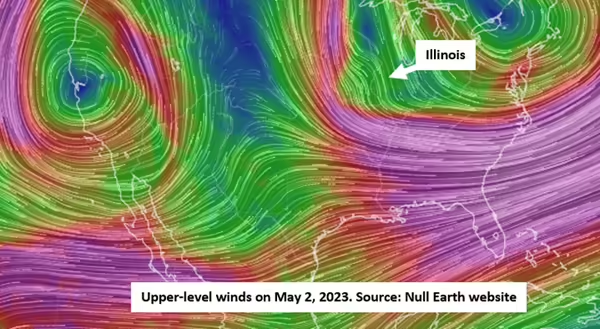
Earlier this week very strong winds blowing dust across a south central Illinois highway suddenly reduced visibility to just a few feet and resulted in a tragic fatal multi-car pile-up. While extremely strong winds don’t occur often, it does seem like this spring in Illinois has been windier than usual.
What causes wind?
Wind is caused by air moving to equalize differences in air pressure. Air pressure is the force exerted due to the mass or weight of air. These differences are generally not great, but the greater the difference in pressure, and the closer the differences are, the faster the wind will move.
One rhyme to remember is “air will blow from high to low.” In other words, air moves away from high air pressure to areas of lower air pressure. The spin of the earth affects this movement, but that discussion can wait for another time. The other general weather rule is that low pressure is associated with clouds and storms, while high pressure is associated with fair weather.
Why so much wind this spring?
Spring is normally a time of faster wind speeds in the Midwest. The jet stream is the driver of mid-latitude cyclones and shows up as the L’s or low air pressure areas you see on a weather map. The jet stream is often located over the Midwest this time of year, moving in a wavy fashion from west to east. As the jet waves move, that brings about changes in air pressure, and winds associated with those changes.
But are we windier than normal?
Multiple reports throughout the Midwest and the Great Plains have indicated this has been a winder spring than average. The jet stream has been very wavy the past few months, and the bigger the wave is, the stormier it can be, depending on where the wave is at.
At the time I’m writing this, the U.S. is being affected by what’s called an Omega block. To understand this, we need to look at what’s happening around 30,000 feet up. At that elevation, there is a big area of high pressure sandwiched between two areas of low pressure. The jet stream is moving in between these lows and the high.
Think of a big upside-down U in the jet stream, with Illinois sitting on the right side of the downward U. To the west in the Great Plains, they will have dry and warm conditions with not much wind. To the east, they will have cool, cloudy, and wetter than normal conditions. Illinois is on the edge of both. This puts us close enough to the low pressure to create cold winds out of the north, but not close enough to have much chance of precipitation as long as the block is in place. These blocks create big differences in air pressure, thus resulting in strong winds near the lows.
Studies seem to be showing winds in general have trended stronger over the last 10 to 20 years. However, in future decades, winds may become slower, according to some climate scenarios.
Today, dust storms don’t occur very often in Illinois, but with the windier conditions we have had this spring, some areas have seen soil in the top few inches dry out, making it easier for winds to pick up soil particles, especially when winds gusted to near 50 mph at the time of this week’s storm.
Right after the last Ice Age ended about 10,000 to 14,000 years ago, huge long-lasting dust storms covered much of the central Midwest. Large amounts of sediment had been deposited in the Illinois and Mississippi River valleys from torrential floods from the ice melt. When the sediment dried out, this fine, floury textured material, called loess, blew out from the river valleys. Dunes 25 feet or higher next to the valleys were created. Blowing out for hundreds of miles, more distant areas were covered with 2 to 4 feet of this material. After several more millennia, this wind-blown loess became the incredibly productive prairie soil we have today.
References
- Multiplatform evaluation of global trends in wind speed and wave height, Science
- It's been unusually windy, University of Colorado Boulder
- Here's why it's been so windy in the St. Louis area, KSDK St. Louis
- Global ‘Stilling’: Is Climate Change Slowing Down the Wind?, Yale University
-
'Localized' Illinois dust storms fueled by rare chain of weather events, Daily Herald
Duane Friend is the Illinois Master Naturalist Coordinator and Climate Specialist with University of Illinois Extension, serving the organization in many roles since 1993. Duane provides information and educational programs to adult and youth audiences in the areas of soil quality, weather and climate, energy conservation, and disaster preparedness. These programs provide practical solutions for families, farms, and communities. He assists families in creating a household emergency plan, farmers with the implementation of soil management and conservation practices, and local government officials and business owners with energy conservation techniques.
All About Weather explores the environment, climate, and weather topics for Illinois. Get in-depth information about things your weather app doesn't cover, from summer droughts to shifting weather patterns. Never miss a new post! Sign up for our email list.